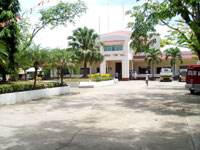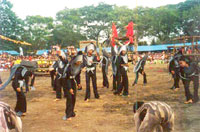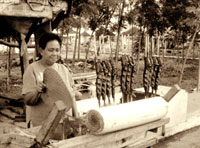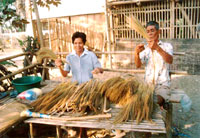Zarraga to celebrate 4th Pantat Festival

Pantat Festival is Zarraga's biggest fiesta aimed at promoting pantat production as a promising agro-industry of the province held every 3rd week of December. In choreographed movement, participating tribes, mostly clad in traditional fishermen's outfit or wrapped in black cloth symbolizing the pantat dances in a synchronized manner to the beat of the drums. With this year's theme "Pantatan Pamuaron, Dunang Manggad Tatapun, Panghimanwa Pasanyugon," the people of Zarraga headed by their municipal mayor Gregorio S. Brazas is inviting everyone to join them in celebrating the 4th Pantat Festival from December 19-23, 2006. Highlights of this 5-day celebration is the Pantat Cooking Contest in partnership with Unilever Philippines scheduled for December 22 and the Tribe Competition on December 23, 2006.
 Zarraga is ever thankful to its pantat industry playing a dominant role in the town's economy. For some time, economic development depended on their production of catfish. The Zarraga Pantat Producers Association (ZAPA), re-organized in July of 2006 and currently with 23 members is the sole mover in the propagation of hito hatcheries in the different barangays, making the town known as the provinces' "pantat capital" and the region's trading center.
Zarraga is ever thankful to its pantat industry playing a dominant role in the town's economy. For some time, economic development depended on their production of catfish. The Zarraga Pantat Producers Association (ZAPA), re-organized in July of 2006 and currently with 23 members is the sole mover in the propagation of hito hatcheries in the different barangays, making the town known as the provinces' "pantat capital" and the region's trading center.
The pantat barbecue is an additional authentic cuisine from Zarraga that contributes in making Iloilo as a big gastronomic adventure. From well-known restaurants as well as alongside streets, pantat is being sold in retail, cooked or alive along the town's highway.
 Zarraga has its share of heritage site that is commonly seen dotting every town in the province, a living testimony to its colonial past. It has preserved its colonial atmosphere with squares, and a few houses built in typical Spanish style. Located at the back of the town plaza is the Doronila house built in 1930 and the Gustilo Castilla house in Barangay Balud Liloan built in 1860. The strength of the people living in these houses is reflected in the sturdiness of its structure with massive hardwood floorings and balustrades.
Zarraga has its share of heritage site that is commonly seen dotting every town in the province, a living testimony to its colonial past. It has preserved its colonial atmosphere with squares, and a few houses built in typical Spanish style. Located at the back of the town plaza is the Doronila house built in 1930 and the Gustilo Castilla house in Barangay Balud Liloan built in 1860. The strength of the people living in these houses is reflected in the sturdiness of its structure with massive hardwood floorings and balustrades.
Zarraga has managed to develop its town through the years. At a time the majority of the residents derived their income mainly from palay and sugarcane production. Today, the town is being identified by TESDA as a priority for development of industries. Not known to many, Zarraga has many small workshops producing native products for its outdoor markets. The manufacture of 'paypay' or soft broom made from tigbao, produced in Barangay Sambag, is currently considered as one of its main livelihood. Trainings to upgrade skills on soft broom-making are supported by their local government. Produce is sold at Zarraga market, central market in the city and even reaching the mall of Gaisano City.
Today, the town is being identified by TESDA as a priority for development of industries. Not known to many, Zarraga has many small workshops producing native products for its outdoor markets. The manufacture of 'paypay' or soft broom made from tigbao, produced in Barangay Sambag, is currently considered as one of its main livelihood. Trainings to upgrade skills on soft broom-making are supported by their local government. Produce is sold at Zarraga market, central market in the city and even reaching the mall of Gaisano City.
Nipa-making in Barangay Pajo is another productive industry with the presence of nipa plant flourishing along the Janipa-an Creek, the landing site of Chinese and Muslim traders who bartered goods with the natives during pre-Spanish period. During the summer, the area becomes an eye-catching display of melons, watermelons and honeydews that is simply irresistible for travelers.
(Bombette G. Marin)
